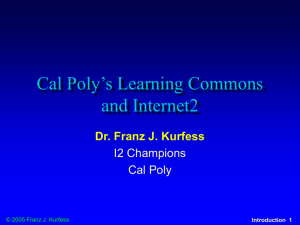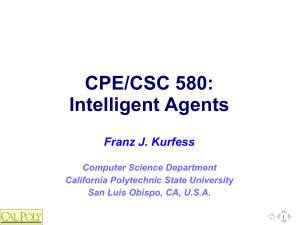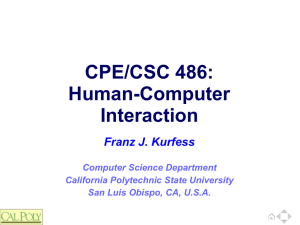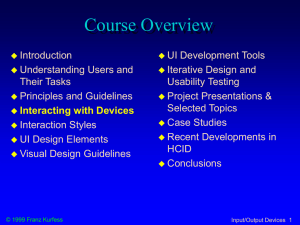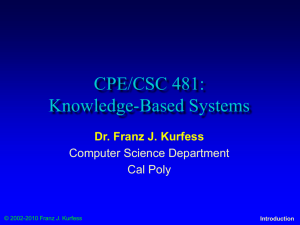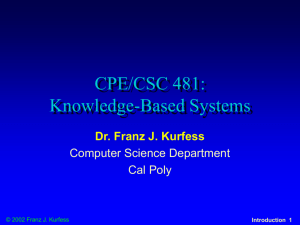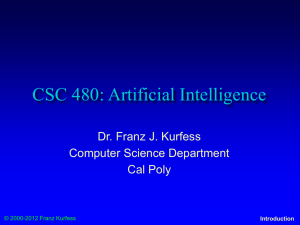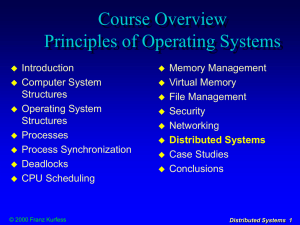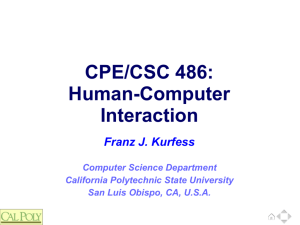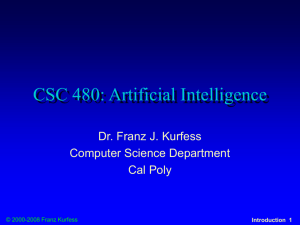486-S12-04-Interaction
advertisement
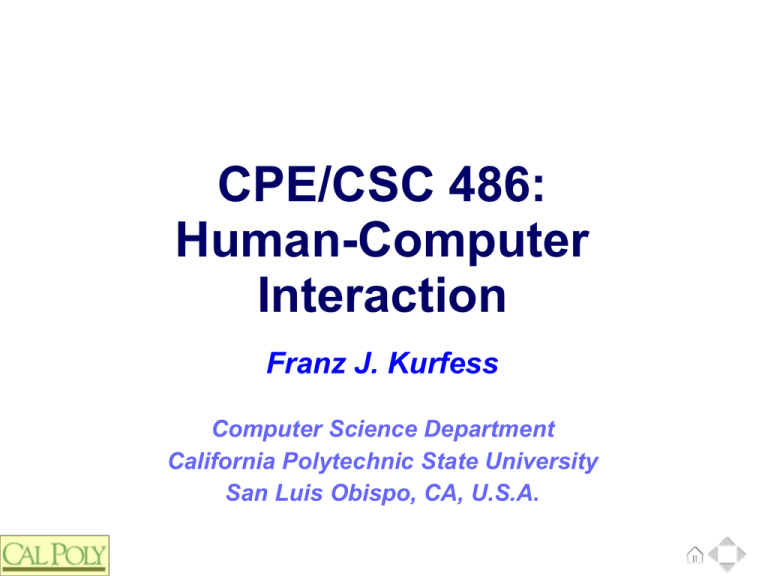
CPE/CSC 486: Human-Computer Interaction Franz J. Kurfess Computer Science Department California Polytechnic State University San Luis Obispo, CA, U.S.A. Course Overview ❖ Introduction ❖ Cognitive Foundations ❖ Input-Output Devices ❖ Interaction Spaces ❖ Interaction Styles ❖ Interaction with Mobile Devices ❖ Speech-Based Interaction ❖ User Assistance © Franz J. Kurfess 3 Chapter Overview Interacting with Devices ❖ Agenda ❖ Motivation ❖ Objectives ❖ Basic Concepts ❖ Problem Space Interaction Information Transmission Channel Encoding Interaction Space Characteristics spatial aspects dimensions proximity temporal aspects © Franz J. Kurfess 4 Logistics ❖ Use of HCI Lab Facilities ❖ Morae reservations for exclusive use of the lab Open House: Fri, April 13 + Sat, April 14 opportunity for usability evaluations and data collection ❖ Loaner Devices Checkout ❖ A1 due today project-related => TRAC Wiki others => PolyLearn Assignment Submission A2 published (same as 484 - A4) Research Activity ❖ iPads, XBox + Kinect, PS3 + Move, Qualcomm Android kits Assignments ❖ Fri ~2:30 - 4:00 pm: new students, parents topic selected? dissemination method discussed (paper, blog, video) Term Project addition of students who enrolled late contact and regular meetings with external customers © Franz J. Kurfess 5 Motivation ❖ the devices used for input and output determine the nature and capacity of information transferred between human and computer ❖ characteristics of the I/O devices influence user interface design to a large degree ❖ the choice of an inappropriate or inadequate design will diminish the performance of the task ❖ combinations of I/O devices can increase the usability of a system © Franz J. Kurfess 10 Objectives ❖ identify the main I/O devices used in computer systems ❖ know the important characteristics of these devices ❖ evaluate the suitability of I/O devices for particular purposes or tasks ❖ be able to select an appropriate combination of I/O devices for a specific task © Franz J. Kurfess 11 Basic Concepts Interaction Spaces Problem Space Interaction Information Transmission Channel Encoding 13 Problem Space ❖ “Interaction Space” in analogy to “Problem Space” abstract space that captures possible interactions analogous to possible solutions in the problem space possibly represented as a graph I’m not sure if this actually works ... may require a suitable abstraction interaction continuous => discrete? path through the interaction space interaction points nodes in the graph spanning the interaction space © Franz J. Kurfess 14 Interaction ❖ sequence of communication activities between two entities ❖ in this context: human computer requires communication channels pairs of compatible actuators and sensors © Franz J. Kurfess 15 Information Transmission Channel ❖ connects a transmitter and a receiver ❖ transmits information possibly affected by noise limited by the channel capacity http://en.wikipedia.org/wiki/Channel_(communications) http://en.wikipedia.org/wiki/Channel_capacity © Franz J. Kurfess 16 Encoding ❖ mapping from a source alphabet to a target alphabet decoding is the reverse operation © Franz J. Kurfess 17 Information Transmission Channels Diagram © Franz J. Kurfess 18 Example: Visual System © Franz J. Kurfess 19 Characteristics Interaction Spaces 20 Spatial Aspects ❖ dimensions ❖ 1D 2D 2.5D 3D proximity direct contact close proximity within reach medium touch within transmission range far beyond transmission range © Franz J. Kurfess 21 Temporal Aspects ❖ dimensions 1D 1.5 D ❖ linear nature of time signals as waves? persistence duration of signal availability sender receiver signal preservation natural via remembering technological via recording © Franz J. Kurfess 22 Signal Transmission ❖ encoding ❖ transmission method ❖ text, icon, image, sound electromagnetic waves light sound direct contact transmission medium natural air, water, solid material technology wire, wireless © Franz J. Kurfess 23 Resilience ❖ capability to resist interference noise multiple signals attention © Franz J. Kurfess 24 Navigation ❖ selection of relevant elements of the interaction space © Franz J. Kurfess 25 Example: Calculator http://en.wikipedia.org/wiki/File:SHARP_ELSIMATE_EL-W221.jpg 26 Interaction Space ❖ domain: simple arithmetic calculations ❖ interaction pressing a number key results in the display of its value sequence of input actions terminated by an operator key yields an output by the device ❖ somewhat simplified information transmission channels calculator => human: visual human => calculator: touch © Franz J. Kurfess 27 Sensor & Actuator Configuration ❖ Input set of keys ❖ labeled with symbols indicating values [0 ... 9] and operations Output 10-digit LCD panel 10 times seven-segment digit additional symbols for operations © Franz J. Kurfess 28 Interaction Space Characteristics ❖ spatial ❖ 2-D arrangement of LCD panel and input symbols mostly for convenience spatial arrangement of 7-segment digits is important decimal system with powers of 10 very limited 2-D display with powers of 10 as horizontal dimension digits indicate value for the vertical dimension temporal 1-D sequential persistence high: signal remains until it is overwritten © Franz J. Kurfess 29 Channel Capacity: Human => Device ❖ ~ 30 keys ❖ no chording ❖ no modifier keys ❖ limited input sequence precision: limit on numerical digits limit on operations unclear ❖ internal memory limit? input speed ~ 1 key / second more limited by human capabilities than by device constraints © Franz J. Kurfess 30 Channel Capacity: Device => Human ❖ 10 times 7-segment display all can be simultaneously active ❖ ❖ ~10 additional symbols limited simultaneous activity some act as modifier symbols minus symbol for negative values decimal points limited output no sequences: all values displayed simultaneously ❖ equivalent of chording in input devices with the exception of input confirmation for pressed keys limited to 10 numerical digits precision magnitude output response time ~ tenths of seconds (estimate) “fast enough” for human capabilities possibly slower for complex calculations © Franz J. Kurfess 31 Activity: Interaction with a Simple Device http://en.wikipedia.org/wiki/File:SHARP_ELSIMATE_EL-W221.jpg 32 Interaction Space ❖ domain ❖ interaction method ❖ ❖ ❖ ❖ brief, informal description information transmission channels device => human human => device Sensor & Actuator Configuration Input Output Interaction Space Characteristics spatial temporal Channel Capacity: Human => Device keys © Franz J. Kurfess 33 Important Concepts and Terms ❖ auditory input/output ❖ brain-computer interaction (BCI) ❖ button ❖ camera ❖ controls ❖ cursor keys ❖ display ❖ handwriting recognition ❖ human-machine interface ❖ icon ❖ input devices ❖ joystick ❖ key ❖ keyboard ❖ microphone ❖ monitor ❖ mouse © Franz J. Kurfess 36 Additional Reading © Franz J. Kurfess [Mustillo] 37 Chapter Summary © Franz J. Kurfess 38 © Franz J. Kurfess 39
